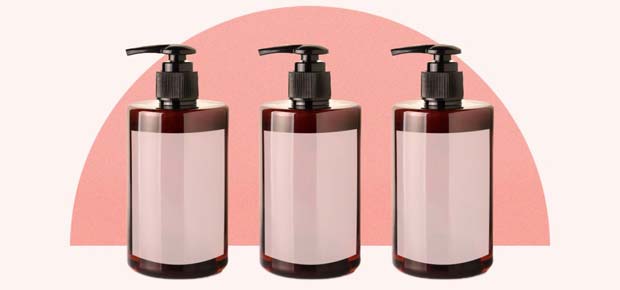Shampoos are common hair caring products that are used to remove oils, dirt, skin particles, dandruff, environmental pollutants and other contaminants, which gradually buildup in the hair. The basic objective of using a shampoo is to remove the unwanted particles and buildup without stripping so much as to make the hair unmanageable. A shampoo, when lathered with water is a surfactant that while cleaning the hair and scalp can remove the excess oils that lubricate the hair shaft.
Shampooing is usually followed by conditioners, which improve the ease of combing and styling.

Types
A variety of shampoos are available in the industry that can be selected on
the basis of your hair type, its condition and the effect you desire.
Generally the shampoos can be categorized into four main types -
Formulation
Shampoos are generally formulated using detergents, thickeners and
opacifiers, foaming agents, conditioners, sequestering agents, specialty
additives, pH adjusters and other ingredients (eg, fragrances, softeners and
preservatives).
Detergents are the primary components in a shampoo that are used for sebum and dirt removal; however, excessive removal of sebum may make the hair look dull, susceptible to static electricity and difficult to comb. In addition, consumers usually equate cleansing ability of a shampoo with abundant, long-lasting foam. As a matter of fact, excessive bubbles are not necessary to make a good hair cleansing and bacteria removal product, but shampoo manufacturers add large amount of detergents, along with foam boosters, to produce the foam, which consumer's desire. The increased usage of detergent creates the need to use conditioners and various other additives in shampoos so as to increase their cosmetic acceptability.
How it works?
A shampoo cleans the hair by stripping sebum (an oil, which is secreted by
hair follicles) from the hair. Sebum functions to protect the protein
structure of hair from damage, however it tends to collect and build dirt,
styling products, and scalp flakes. Surfactants strip the sebum from the
hair shafts, thereby remove the dirt and other impurities attached to it.
While both the soaps and shampoos contain surfactants, soap bonds to oils with such affinity that it removes too much oil if used on hair. Shampoos are based on another class of surfactants, which are balanced so as to avoid removing too much oil from hair.
The chemical mechanisms, which underlie hair cleansing, are similar in nature to that of traditional soaps. Undamaged hair has a hydrophobic surface to which skin lipids like sebum stick, but water is repelled at the beginning. When the hair is rinsed with plain water, the lipids do not come off easily. The anionic surfactants considerably reduce the interfacial surface tension and provide for the removal of the sebum from the hair shaft. The non-polar oily materials that are present on the hair shaft are soluble into the surfactant micelle structures of the shampoo and are removed during the process of rinsing. There is also significant removal through a surfactant and oil "roll up" result. The foamy effect, which is obtained by massaging shampoo into the hair is completely aesthetic.
Usage Tips
Thoroughly saturate scalp and hair using cool or mild warm water (hot water
tends to dry out hair and scalp). Apply a small amount of shampoo to palm
and rub hands together to distribute it evenly. Now apply the shampoo to
scalp with your finger balls. The basic objective of shampooing is to clean
your scalp and not wrestle your hair, hence concentrate on massaging gently
and allow the suds to be distributed throughout the hair while rinsing. It
is not necessary to do the "rinse and repeat" routine, unless you
have an oily scalp condition.
Shampoo - Buying Tips
While buying a shampoo, it is important to remember that a variety of
shampoo products are available in the market that is designed and formulated
for different hair types and conditions. So it is necessary that you use a
shampoo that suits your particular hair type and condition. You can buy a
basic shampoo if you want normal cleaning and conditioning of hair. Basic
shampoos come in 4 different types, namely - Dry hair shampoo, oily hair
shampoo, normal hair shampoo and damaged hair shampoo. If you are having
dandruff or any other bacterial infection problem in your hair, consider
buying a medicated shampoo. If you need to buy a shampoo for a baby, then
buy a baby shampoo, as they are gentle enough for the sensitive skin of a
baby. You can also buy a conditioning shampoo (Shampoo + Conditioner), if
you do not want to use a conditioner following the use of shampoo.
Carefully read the ingredients to make sure that the shampoo you are going to use on your hair does not contain any harmful chemicals or toxins. You may also consider buying natural herbal shampoos that are made using natural ingredients like shikakai, herbal extracts, essential oils and fragrances.

If you have decided to make soap at home, you will need soap making supplies in the form of raw materials, soap making equipment & tools ...
Read More
Someone has rightly said that clothes are not just clothes. They form an integral part of a person's personality and tell a lot about their nature and...
Read MoreCleansing products play an important role in the daily lives of people.
Both soaps and detergents are cleansing products that we frequently use in our
Soap is designed as a product to be used once and then flushed down the drain...